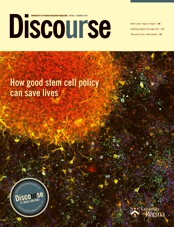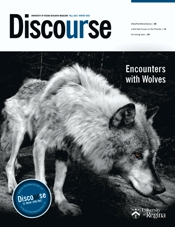Dr. Andrew Cameron, associate professor of biology at the University of Regina and co-director of the Institute for Microbial Systems and Society, at Neck Point Park in Nanaimo, BC. (Photo by Kayla Mohns)

Dr. Andrew Cameron can precisely trace the roots of his current work—using genomics to understand the novel coronavirus, COVID-19—to the opportunity he had as an undergrad to travel to Belize with the Canadian International Development Agency (now a wing of Global Affairs Canada) to study water quality.
Living and working in Central America was a “wild experience” for a budding young scientist, recalls Cameron. Paddling down the Belize River, he saw raw sewage being pumped directly into the same water that a kilometre further downstream kids were playing in and mothers were drawing for cooking, drinking, and washing.
Studying that relationship between infectious microbes and people using the river, that’s really how I got started,” says Cameron, an associate professor of biology at the University of Regina and co-director of the Institute for Microbial Systems and Society (IMSS). “That’s essentially how I got into working on infectious diseases.”
CONNECTING CORONAVIRUS IN BATS AND THE COV3R PROJECT
Fast forward to 2021, and Cameron and his research team are part of the $430,000 COVID-19 Rapid Regional Response (COV3R) project funded by Genome Prairie and the Saskatchewan Health Research Foundation (SHRF). Working with the provincial labs in Saskatchewan, Manitoba, and BC, Cameron and his colleagues are using genomic techniques to spot and study variations in the coronavirus and to identify co-infections in western Canadians who test positive for COVID.
“Microbes are fantastic because they represent most of the biological diversity on earth. Most of the evolutionary history of biology is captured in microbes.”
For several years prior to the COVID-19 pandemic, Cameron had been gearing up to study viral diversity in animals, trying to understand which viruses had the potential to jump from animals to humans. When “virus hunter” colleagues found several coronaviruses in bats from the Democratic Republic of Congo (DRC) that didn’t match previously identified coronaviruses, Cameron quickly requested that samples be sent to the U of R lab. In 2019, the scientific world didn’t know much about coronavirus diversity. “It’s a big group of viruses, but very little research had been done on it outside of SARS and MERS,” says Cameron.
He and his team were eager to use a technique called probe capture to isolate and map the virus’s genetic material. The team wanted to find out more about coronaviruses in bats and how their genes compared to other known coronaviruses. After most of 2019 was spent sorting out paperwork and shipping arrangements, the samples from the DRC bats arrived at Cameron’s lab in December 2019, only a month before news of the troubling new virus began to dominate headlines and newscasts.
When the federal government made funding available for researchers to pursue a variety of different approaches to understanding the emerging pandemic, Cameron and his team were well positioned to move quickly. “We'd already been thinking about coronaviruses and diversity and different ways to isolate their genetic material to sequence their genomes.”

THE EDUCATION OF A BIOLOGIST
Cameron’s fascination with the living world began at an early age. Growing up on Vancouver Island, he could walk out the back door of his Nanaimo home and instantly be surrounded by nature. “As a kid, I spent a lot of time hiking through the forest behind the house and just exploring.” Cameron gravitated toward the sciences in high school. “I enjoyed the quality of science, the ability to understand the natural world in a really rigorous way, to make predictive models and assumptions about the world and be able to test them,” says Cameron. “I always liked that about science—that there was that very effective, structured way to understand the natural world and why things do the things they do.”
After high school, Cameron did an honours degree equivalent in biology at what was then Malaspina University College in Nanaimo (now Vancouver Island University). “That’s really where I got my first love for and ability to explore biology.”
As part of the program, he had the opportunity to work in a lab. He credits that experience—and the faculty and professors who guided his work there—with planting the seed for going on to grad school, to do research full time.
“We now know that genetic analysis from sequencing all the DNA or RNA in a bacterium or a virus is the most powerful way to understand an outbreak.”
Across the Strait of Georgia at UBC, Cameron combined his fascination for bacteria with the study of evolution for his PhD, working under zoologist Dr. Rosemary Redfield. “I knew I wanted to work in something evolutionary,” says Cameron. “Microbes are fantastic because they represent most of the biological diversity on earth. Most of the evolutionary history of biology is captured in microbes.”
When he completed his doctorate in 2007, Cameron was curious about the scientific culture in Europe; he wanted to see what was going on in his field on the other side of the Atlantic. At Trinity College in Dublin, under Dr. Charles Dorman, Cameron studied Salmonella—specifically how the bacteria “reads” its host environment, then does a complex cost-benefit analysis to determine whether it’s worth the risk to go on the attack.
SCIENTIFIC WINS
Cameron counts among his career successes the detective work he and long-time collaborator Dr. David Alexander did in 2014 to sleuth out the source of Salmonella infections in Saskatchewan. Using DNA sequencing, the partnership between the Saskatchewan Disease Control Laboratory and the Cameron lab was able to determine with 100 per cent certainty that two cases had in fact originated in laboratories, including one in the very facility responsible for identifying the bacteria when it shows up in the community.
That project laid the foundation for all of the subsequent genome sequencing he’s done to better understand infectious diseases from a public health perspective, such as transmission routes, sources of infection, the location of potential outbreaks, and how infections evolve.

“We now know that genetic analysis from sequencing all the DNA or RNA in a bacterium or a virus is the most powerful way to understand an outbreak.”
Another big win, says Cameron, was working with Alexander to help solve the mystery of how a nasty bacterial lung infection that appeared in the United States quickly mutated to become resistant to a brand-new antibiotic called Bedaquiline. Scientists and clinicians spent many years trying to find an antibiotic that nature had never seen before, and Bedaquiline was the result. Yet, within two months of its introduction, the infections returned in seven of the 13 hospitalized patients who had been treated with it. And in each of those seven cases, the bacteria independently evolved their own resistance mutations.
“By using DNA sequencing, we could zero right in and see, how did that happen so fast?” recalls Cameron. “How did the bacterium evolve to resist our most powerful tool, which took years to develop, and, just like that, they solve the problem for themselves?” Today, thanks in part to that work, instead of waiting months for bacteria to grow in the lab to determine which antibiotics may be useful, labs can now run genetic diagnostics on patient samples and know the next day which combinations of drugs will be most effective. “That’s why we're so excited about bringing gene sequencing to public health as fast as possible, because it can help with these multiple types of problems around infectious diseases.”
MENTORSHIP MATTERS
In his lab and in the classes he teaches, Cameron tries to nurture the same passion for discovery that was kindled in him as a young researcher, and to provide the next generation of scientists with the same opportunities he had to pursue their interests and research questions.
Master’s student Danae Suchan took her first upper-level biology course from Cameron back in 2015. Based on that experience, she knew she wanted him to supervise her master’s degree. “That’s what got me hooked in the first place,” says Suchan, who is a key member of Cameron’s COV3R team and whose graduate research looks at the gut microbiomes of bats in South Africa and mongooses in Botswana. “Andrew has a knack for communicating about science in a way that inspires people to want to get involved in research.”

She’s appreciated having Cameron as a mentor. “He’s an excellent facilitator of science because he is constantly securing funding and making connections with collaborators internationally. He’s always finding this diverse array of projects for me and other people in his lab to work on. He’s looking out for me and supporting my goals, not just his lab’s goal.”
People who work with him say Cameron’s passion for discovery research, with its unpredictable zigs and zags, is, well, infectious. Dr. Kara Loos, research associate and lab manager for the Faculty of Science at the University, first met Cameron when he came to U of R in 2012. She was doing her PhD at the time and Cameron ended up joining her thesis committee. Loos was later recruited by Cameron and Dr. Christopher Yost, co-director of the IMSS, to manage the Institute’s lab.

“I've heard before that science has a 90 per cent failure rate,” says Loos. “That can be hard to stomach when you’re with all of these overachievers in grad school and you want to do the best you can. But what happens when you get failure after failure after failure? Andrew has this unique ability to see the positive in everything. A lot of supervisors would say, ‘Hey, you've poured all this money into this experiment and it didn't work.’ Some people might get quite grumpy about that. But Andrew understands that it’s all just part of the scientific method.”
TEAM BUILDING
As part of the COV3R project, Cameron invited Kevin Kuchinski, a PhD candidate in UBC’s Department of Pathology and Laboratory Medicine, to spend time with his team in summer 2020, training them to use his novel probe capture technique to isolate genetic material from unidentified viruses and virus variants.
“While my team could do probe capture with components bought from different suppliers, using the techniques Kevin developed through his PhD made our work significantly more effective,” says Cameron.
Kuchinski, who conducts his research at the BC Centre for Disease Control, enjoyed his time at the U of R. He appreciated Cameron involving him in lab meetings and presentations by students and others in the department, and says it was a nice change of pace to work with Cameron’s team and be in an academic laboratory environment again.
What Kuchinski likes best about collaborating with Cameron is that he’s surrounded himself with such a strong team. “I've found that the good labs aren't always the ones with the superstar PIs [principal investigators]—they're the ones with good teams,” says Kuchinski. “So maybe part of what makes a superstar PI is being able to foster and cultivate a good team. Andrew has really done that with his lab.”

IMMEASURABLE VALUE OF DISCOVERY RESEARCH
Cameron is a tireless champion of fundamental research—or what he prefers to call discovery research. He says that despite the appearance at times that we’re losing the fight to COVID-19, discovery research is what has enabled the scientific community to respond as quickly as it has.
“Everything we do in the lab is based on fundamentals that scientists have had to figure out over the years,” says Cameron. “None of this would be possible if it wasn't for countless big and small steps, including solving the structure of DNA or going all the way back to Darwin, who figured out the idea of descent from common ancestors.”
He points out that every instrument used in today’s laboratories is based on principles that were developed by scientists who, at the time they developed them, had no idea they would be applied to things like pandemics.
“We don’t always know what the applications are going to be later on down the road, but we know that they're going to be useful,” says Cameron. “That's why we do discovery of the natural world.”












